New opportunities and a few old issues as Wickremesinghe comes calling
The Sri Lankan President, who begins his first visit to India after taking charge on July 20, has long been an advocate of close bilateral ties. But he will be in New Delhi for just a day, and he will be carrying some baggage as well.
 Prime Minister Narendra Modi shaking hands with his Sri Lankan counterpart Ranil Wickremesinghe before a meeting in New Delhi on October 20, 2018. (Express photo by Tashi Tobgyal)
Prime Minister Narendra Modi shaking hands with his Sri Lankan counterpart Ranil Wickremesinghe before a meeting in New Delhi on October 20, 2018. (Express photo by Tashi Tobgyal) Sri Lanka’s President Ranil Wickremesinghe will arrive in Delhi for two-day official visit on July 20, the first anniversary of his election to office in extraordinary circumstances by the country’s Parliament. Sri Lanka’s Presidents are directly elected — but Wickremesinghe’s predecessor Gotabaya Rajapaksa had been dramatically swept out of office by a popular movement that emerged out of the Sri Lankan economic crisis. Earlier, in an attempt defuse the protests, Rajapaksa had appointed Wickremesinghe as his Prime Minister.
In India-Sri Lanka relations, a year is a long time for a new President to be making his first official visit to New Delhi. Over the last three decades, it has been the practice for India to receive a new Sri Lankan head of state within weeks. In November 2019, External Affairs Minister S Jaishankar had broken that tradition to rush to Colombo within three days of Rajapaksa’s election as President, and invited him to New Delhi. Rajapaksa had visited on November 29, 2019, in the same month as he took office.
A certain absence of warmth
With Wickremesinghe, New Delhi has been politically standoffish even while helping Sri Lanka with financial assistance and handholding through the negotiations with the IMF for the $3 bn bailout. Upon his election, India’s message lacked the customary warmth conveyed on such occasions.
It noted his election by Parliament, and underlined that India, as a close friend and neighbour, would “continue to be supportive of the quest of the people of Sri Lanka for stability and economic recovery, through democratic means and values, established democratic institutions and constitutional framework”. Prime Minister Narendra Modi sent a message of congratulations to Wickremesinghe after a week.
The Sri Lankan President, whose United National Party was defeated in the 2019 parliamentary elections – he too lost his seat and entered Parliament as a nominated member – was voted in by the party of the discredited Rajapaksas, driven out of office by the Argalaya movement. As such, some view him as a placeholder for the Rajapaksas.
New Delhi does not have a good institutional memory of Wickremesinghe. The Indian establishment believes that as Prime Minister during the presidency of Maithripala Sirisena from 2015 to 2018, Wickremesinghe “failed to deliver” on commitments.
An MoU listing several joint projects was signed when Wickremesinghe visited in 2017, including the development of the Trincomalee oil tank farm, and a Comprehensive Economic Partnership Agreement (CEPA). But there was no forward movement on any of the listed items as relations between the top two leaders in Colombo soured and a paralysis of governance set in.
It was also under Wickremsinghe’s stewardship that Hambantota port was sold to the same state-owned Chinese company that had built it, to settle debts.
More recently, soon after Wickremesinghe assumed office, the docking in Hamabantota of Yuan Wang 5, which both Sri Lanka and China described as a “scientific research vessel”, but which India called a “surveillance” ship with strategic capabilities, was another letdown for New Delhi — especially because India had, only months previously, gone all out to bail out Sri Lanka with credit lines and financial assistance worth $4 billion.
Ahead of Wickremesinghe’s visit, the Sri Lankan newspaper The Sunday Times has noted in an editorial that it the President “will be in Delhi for just over 27 hours” — arriving late on Thursday night, and leaving on Friday night, and that he will be on an official visit and not a state visit, and will have hardly any time to rebuild a rapport with the Indian leadership.
Wickremesinghe’s advocacy of closer ties with India
Still, the 73-year-old Wickremesinghe, has been the most ardent advocate of closer ties with India, including “economic integration”. In 2015, as Sri Lanka voted to defeat Mahinda Rajapaksa and Wickremesinghe became part of a “national unity government” for good governance with Sirisena, he re-upped an idea he had promoted in the early 2000s – of a land bridge between the two countries, opening out the island’s connectivity, and its exports to more markets. It is another matter that he lacked the political capital to finalise the CEPA that India was pushing.
Now, with Sri Lanka still in dire economic straits, and facing a tough path of debt restructuring and economic reforms to meet IMF conditions and restore country confidence in other creditors, Wickremesinghe has been pushing once again for closer ties with India.
Soon after he took charge, the President called for “bilateral agreements with deeper integration and carving special trade areas” with India’s southern states, which are also the most developed part of the country.
In an interaction earlier this month with the Indian CEOs Forum ahead of his visit, Wickremesinghe said: “It is crucial to recognise that the relationship between our countries is not solely driven by governments but by our people, who are moving forward at rapid pace. We must adapt to the changing world, avoiding the pitfalls that come with government intransigence. Hence we must foster a long-term relationship between our two nations, transcending individual leaders or political parties. Together India and Sri Lanka possess immense potential, and it is our path forward.”
Wickremesinghe spoke about “aligning [Sri Lanka’s] path with India”, through a “massive overhaul” of the Sri Lankan economy, its laws and other systems. “India and Sri Lanka should embark on this transformative journey together, as we have for the past 2,500 years,” he said.
India had undergone an economic transformation under the Modi government, Wickremsinghe said, and it was now “India’s time in the Indian Ocean”.
“The idea is we go there, and establish a long-term relationship. It’s not between two individuals. It is not between the BJP government and this government. It’s a relationship between two countries, and that’s the journey that we should go. There’s a lot we can do together,” Wickremesinghe said.
Old suspicions and new outreaches
Last year, as New Delhi finalised its financial assistance to Colombo – it was the only country to respond to Sri Lanka’s economic crisis – many long- pending projects fell into place, including the Trincomalee oil tank farm deal and a renewable energy project (originally meant to be a coal fired thermal plant) in nearby Sampur.
The Adani group finalised an agreement to set up a wind farm in Mannar on Sri Lanka’s India-facing west coast. The Sri Lankan government agreed to cancel contracts to a Chinese firm to set up hybrid solar and wind projects in islands off Jaffna.
Flights began between Jaffna’s Palaly airport and Chennai, daily from July 15. More connectivity projects between Jaffna and Tamil Nadu are in the pipeline. Mega private investments are also rumoured, including by Tata.
Though India tried to avoid a quid pro quo impression, on the Sri Lanka street, this is exactly how it is seen – that their country has paid a heavy price for India’s money, and that India is extracting every paisa’s worth. The suspicion about India’s intentions go back to the 1980s, when Delhi trained Tamil militant groups – which had sprung up from the 1970s in response to discrimination by the majority Sinhala-Buddhists — in their armed struggle for an Eelam state.
The intervention culminated in the 1987 India-Sri Lanka Accord and the deployment of the Indian Army in northern and eastern Sri Lanka as the Indian Peace Keeping Force, creating deep resentment in southern Sri Lanka.
Wickremesinghe has sought to address this sentiment too.
“What are the long time goals and objectives of our relationship? We have to decide within the next two decades what is our relationship going to be and what is the connectivity We can’t be suspicious of each other, we have to work together,” he said at the CEOs’ Forum, suggesting that he was prepared to debate these questions in the country’s Parliament, just like he had done the IMF bailout deal.
From Wickremesinghe’s remarks, it seems as if India and Sri Lanka are preparing for the long proposed and back-burnered CEPA, perhaps calling it Economic and Technical Co-operation Agreement.
Sri Lanka’s Energy Minister Kanchana Wijesekera has referred to discussions with Indian Oil Corporation, which has had a retail and lube mixing footprint in Sri Lanka since 2002, on the possibility of an oil pipeline connecting Nagapattinam, Trincomalee, and Colombo.
“I have requested them to look at a two-way oil & gas pipeline, taking into consideration the government’s development plan for Trinco tank far, and energy hub, future developments of refineries, oil and gas exploration, pipeline connections to domestic LPG terminals…,” Wijesekera said.
The Sri Lankan side has also proposed joining the Indian electricity grid through undersea cables, and the feasibility of this is being studied.
The persisting Tamil question
Last week, some 20 Tamil groups and political parties held a public meeting in Jaffna – a rare instance of so many groups sharing a platform after many years — demanding that as a signatory to the 1987 Accord, India must fulfill its role as guarantor of this agreement, ensuring that Sri Lanka implements the 13th Amendment in full to grant provincial autonomy to the Tamil dominated-Northern Province.
The amendment was introduced in the Sri Lankan constitution under the provisions of the Accord. But it has never been fully implemented, with the government especially holding back land and police powers. Speakers noted that had a fully empowered provincial government been in existence, they would have been better able to tackle what they called the “Sinhalisation” of the North.
Speakers urged the Tamil community to learn from the 30-year civil war and not be swayed by pipe dreams being offered by some sections of Tamils. Several Tamil parties and groups have written to Prime Minister Modi to raise the issue with Wickremesinghe during the visit. A diaspora group of progressive Sri Lanka Tamils called Well Wishers of Tamils in Sri Lanka has also written to Modi asking him to “persuade” the visiting leader to “give a firm committment to hold the provincial council elections”, and “set a definite time frame” for the full and proper devolution of powers under the 13th Amendment.
Amid the clamour, Wickremsinghe, who had earlier this year promised that provincial council elections would be held, invited Tamil political parties for a meeting, which was scheduled to take place at 3 pm on Tuesday.
There is also a view among some Tamil sections that raising the 13th amendment, ahead of presidential and parliamentary elections in 2024 and 2025 respectively, will help the Rajapaksas reap electoral rewards in southern Sri Lanka by painting it as a “separatist” amendment.
Accompanying Wickremesinghe will be two Tamil ministers, Douglas Devananda of Jaffna who is Minister of Fisheries, and Jeevan Thondaman, an Indian -origin Tamil who leads the Ceylon Workers’ Congress.
The issue of Tamil Nadu fishers poaching in Sri Lanka’s northern waters has divided Tamils on either side of the Palk Strait, and will be brought up by the Sri Lankan side.




- 01
- 02
- 03
- 04
- 05


































